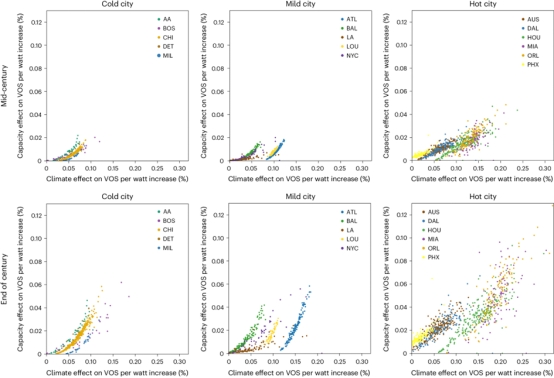Recently, the research team led by Prof. Lu Xi from the Institute for Carbon Neutrality and the School of Environment, Tsinghua University, in collaboration with Assistant Professor Michael T. Craig’s team from the University of Michigan, has made new progress in revealing the dynamic climate value and potential realization of rooftop photovoltaics. Based on the results of future multidimensional climate models, this study quantifies the dual impact of climate change on the photovoltaic generation potential on residential rooftops and energy consumption behavior, revealing the mechanism through which climate change enhances the value of residential rooftop photovoltaics and promotes investment in rooftop photovoltaics. This study quantifies for the first time the impact of climate change on the value of renewable energy applications, providing key scientific guidance for the medium to long-term development and planning of rooftop photovoltaics.
Distributed photovoltaics, represented by rooftop photovoltaics, is a key component driving the future low-carbon and electrification transformation of energy. Unlike large-scale centralized renewable energy sources, the promotion and popularization of distributed photovoltaics investments rely more on the economic and environmental value brought about by local power supply to users. The temperature rise and radiation changes caused by future climate change will alter the “supply-demand” form of distributed photovoltaics from the perspectives of photovoltaic supply and local electricity demand, thereby affecting the value of distributed photovoltaics. Therefore, this study, using sensor data from energy consumption monitoring of over 2000 typical residential users in 17 cities in the United States, simulated the feedback effects of different user energy consumption behaviors on climate change. The study further integrated various future climate models to analyze the changes in photovoltaic potential and energy consumption characteristics of users under different climate scenarios in the mid-century (2020-2059) and end of the century (2060-2099). Based on the comprehensive impact of climate change on “supply-demand,” the study established an optimal scheduling model at the user scale to analyze the photovoltaic benefits and optimal rooftop photovoltaic installation capacity for residents under different climate pathways.
The results show that climate change generally enhances the user benefits of rooftop photovoltaics and motivates residents to further expand their photovoltaic investment capacity. Specifically, under the RCP-4.5 pathway, the average return on investment for rooftop photovoltaics for users in different cities can increase by up to 20%, while the optimal capacity for rooftop photovoltaic investment by urban users can increase by up to 25%.

Diagram illustrating the impact of climate effect and dynamic investment capacity increase on the value of rooftop photovoltaics for users under intermediate climate pathways
The research findings, titled “Climate change will impact the value and optimal adoption of residential rooftop solar,” were published in the prestigious journal “Nature Climate Change.”
Shi Mai, a doctoral student at the School of Environment, Tsinghua University, is the first author of the paper, with Prof. Lu Xi from the Institute for Carbon Neutrality and the School of Environment, Tsinghua University, and Assistant Professor Michael T. Craig from the University of Michigan, serving as the corresponding authors. This research was supported by the National Natural Science Foundation of China, the National Key Research and Development Program, the Carbon Neutrality and Energy System Transformation multilateral joint research project (CNEST), and the Erdos-Tsinghua Carbon Neutrality Innovation and Cooperation Research Project.
Reference
Shi, M., Lu, X. & Craig, M.T. Climate change will impact the value and optimal adoption of residential rooftop solar. Nat. Clim. Chang. (2024).
https://doi.org/10.1038/s41558-024-01978-4
 Latest recommendations
Latest recommendations


